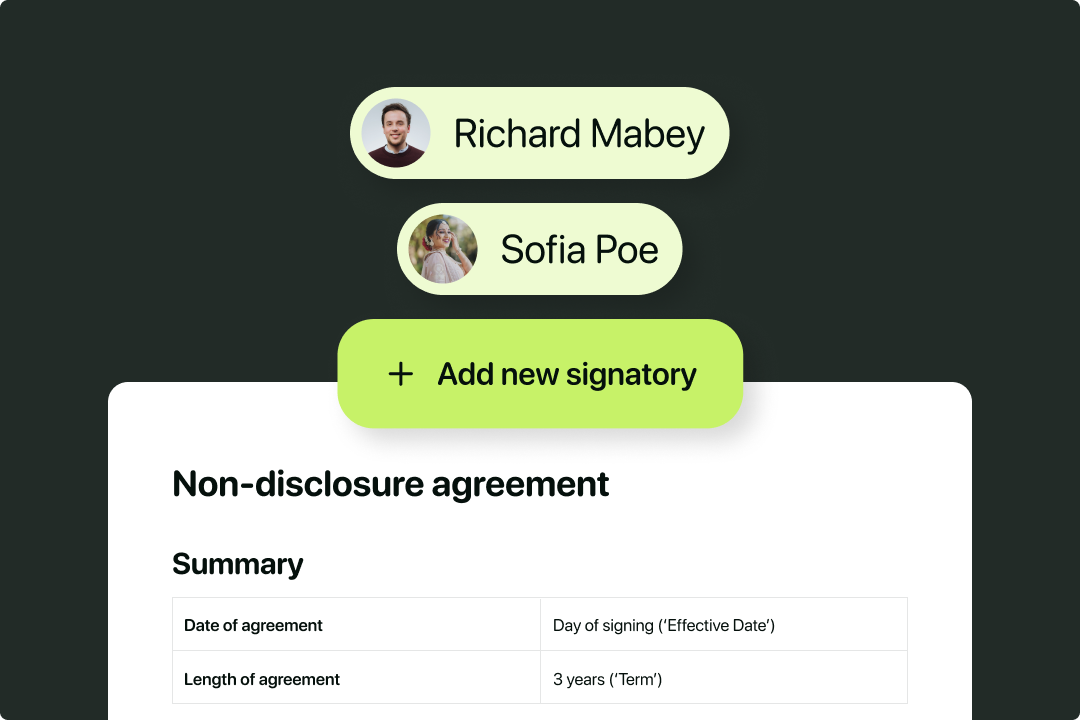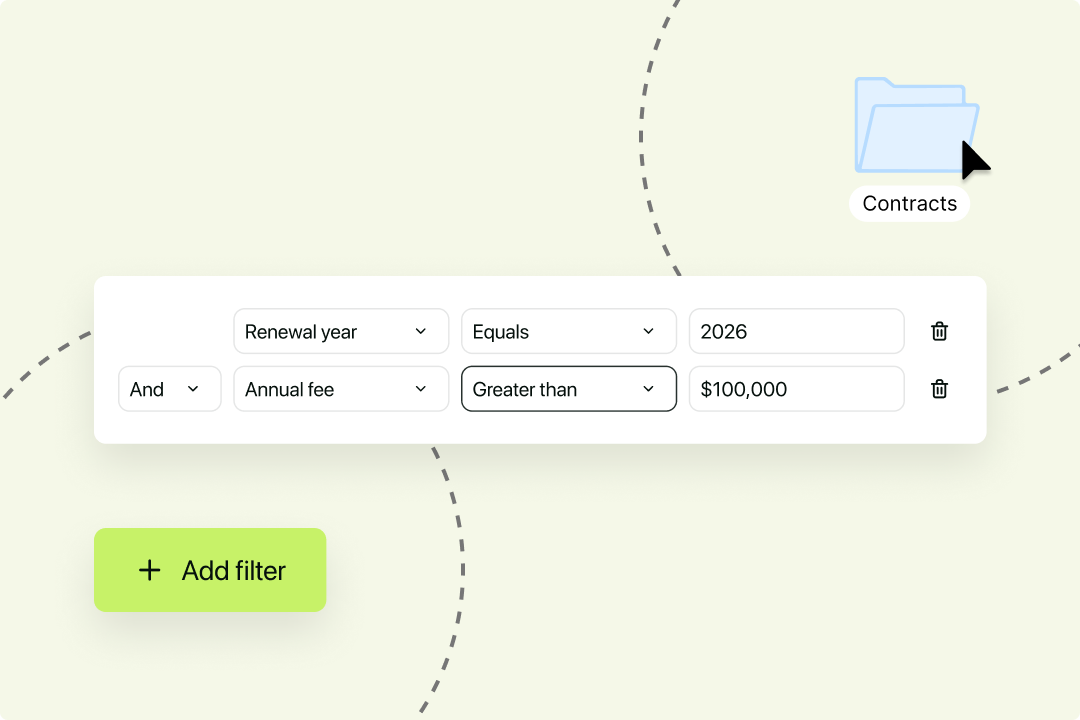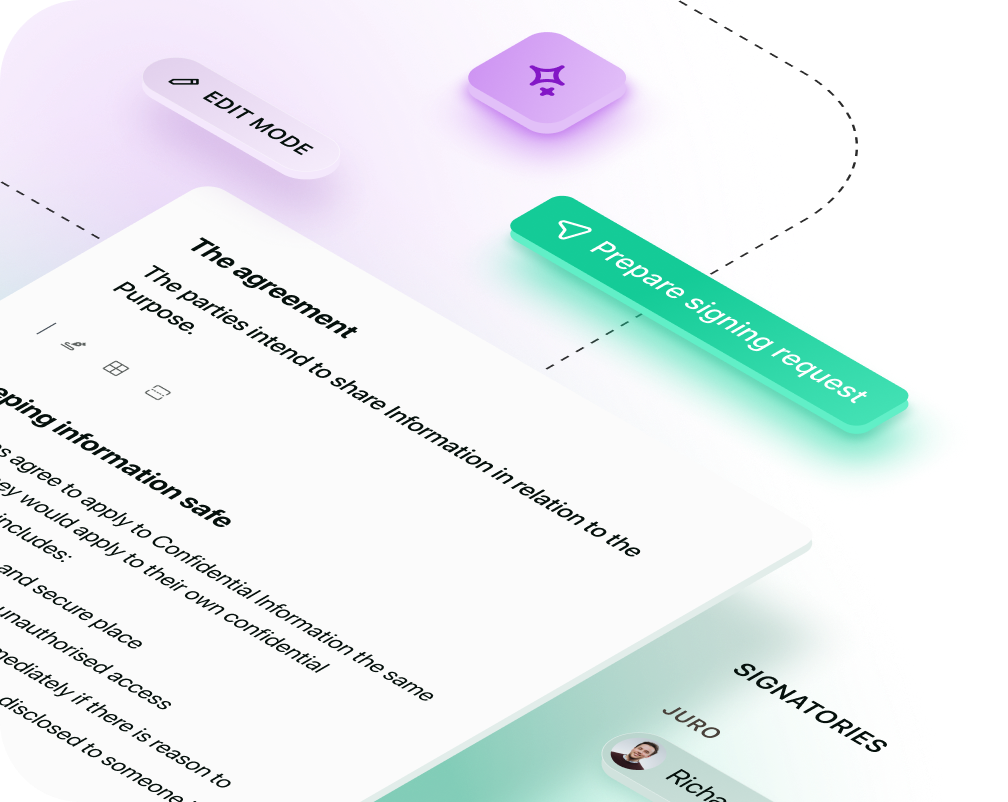Solutions
Customer Support
Resources


Seeking to standardize contract processes but not sure where to start?
Look no further than this detailed guide to crafting and implementing a robust contract management plan. From templates to expert tips, we've got you covered. Together, we'll explore:
A contract management plan (CMP) is a document outlining how a contract will be managed throughout its lifecycle.
The plan provides clarity by defining the roles, responsibilities, key processes, and performance measures to ensure the contract delivers its intended value.
But above all else, a contract management plan makes contracting more predictable for a business by establishing a set of rules and principles all agreements should follow. It’s a way to boost efficiency, reduce manual work, and improve visibility into contracts.

Contracts are at the heart of business operations, but without a clear contract management plan (CMP), they can quickly become a source of inefficiency, risk, and lost value. A quick glance at contract management statistics paints a painful picture of contracting in 2025.
According to Juro's State of In-house report, 38 per cent of in-house lawyers have experienced burnout in the past year. With legal teams under increasing pressure to do more, inefficient contract processes only add to this burden.

Beyond workload management, poor contract processes come at a financial cost. 40 per cent of a contract’s value can be lost due to inefficiencies, and WorldCC estimates that contract value leakage costs businesses up to 9 per cent of their annual turnover.
This isn’t surprising when 40 per cent of organizations admit they lack clarity on who owns contract-related tasks—a gap that leads to missed deadlines, stalled negotiations, and costly mistakes.
To put it bluntly: inefficiency and lack of direction don’t just slow you down—they drain employee well-being and cut into your bottom line.
A contract management plan provides the structure needed to mitigate these risks. By defining ownership, streamlining workflows, and leveraging automation, businesses can unlock contract value rather than lose it.
The introduction of your contract management plan should outline the purpose of the document and how it supports business operations. It lays the expectations for contract governance, compliance, and efficiency, but it also sets the tone on how important adoption of this process is for the wider teams.
It typically covers things like:
"This Contract Management Plan (CMP) ensures that all contracts at [Company Name] are created, reviewed, approved, executed, and stored efficiently. It applies to all commercial, procurement, employment, and partnership agreements. The CMP helps mitigate risks, optimize contract value, and maintain compliance with legal and regulatory requirements."
The best way to convey the importance of effective and compliant contract management is to relay the information in terms other departments can understand.
For example, if you’re appealing to the sales team, you’ll want to put emphasis on benefits like speed of review, counterparty experience, and shorter sales cycles. But if you’re speaking to finance colleagues, you’ll want to focus on benefits like more accurate forecasting, improved data hygiene, and better renewal management.
As Keji Ajayi, CFO at Topi, explains: “Lawyers need to be able to tailor the message to suit the audience - what’s the issue? In its simplest terms, why is this a problem? Why does it concern your team? They need to be able to explain complex legal issues in a way that is easy for the business to understand.”
Next, you’ll clarify the standard roles and responsibilities for a contract either created or signed by the business. Clearly defining roles prevents confusion and ensures accountability for contract-related tasks and encourages individuals to perform tasks more promptly as the task owner.
For instance, contract-related responsibilities are often shared between the following stakeholders:
Naturally, this varies a lot across different organizations. Some smaller teams won’t have a contract administrator, and it’s common for more tasks to land on legal’s desk in these smaller businesses, too.
{{quote1}}
"Each contract must have a designated owner who is responsible for tracking deliverables and ensuring compliance. All high-risk contracts (e.g., involving liability over $500,000) require additional approval from the General Counsel and CFO."
Be forward-thinking when you assign these roles and responsibilities to future-proof them as much as possible. This concept is also known as 10x thinking.
Francesca Porter, Group General Counsel at PolyAI suggests asking yourself the following question:
"If you brought in a new system to automate a certain task, how can you ensure that this system will maximize efficiency in a year’s time when the volume of work is much bigger?"
For example, if you're going to make the CEO the authorized signatory for contracts agreed in large volumes, can you set up a way for that individual to bulk sign agreements before they become unmanageable?
Considering this ahead of time paves the way for a long-lasting and better adopted process that grows with your business, rather than holding it back.
At this point, you'll want to provide greater detail about the processes used to either create or request a contract.
Again, this will vary from business to business, but it's common for the legal team to have a contract request form of some sort, or even better, a legal front door.
It's also useful to provide a rough benchmark for how long a contract turnaround time will be, so that commercial teams know how early to submit their ask.
This section will typically include:

"All new contracts must be created through [Contract Management Platform]. Legal must review any non-standard terms before approval. Contracts exceeding $250,000 require CFO sign-off."
If you're looking to speed up contracting and minimize the turnaround time for contracts, you should consider setting up self-serve workflows for routine agreements instead.
For example, lots of legal teams use Juro to automate contracting for commercial teams, allowing them to generate watertight contracts on demand, and often without leaving Salesforce, HubSpot or Slack.
For example, Talentful's sales reps go from conversation to contract in just a few minutes, without leaving their CRM. Similarly, Placemakr's commercial team generate contracts directly from HubSpot in a few clicks.
{{quote2}}
This is possible because Juro's intelligent contract platform integrates seamlessly with the tools your business teams already know and love, allowing them to generate contracts using your pre-defined, automated templates.
A contract management plan should outline how contracts are negotiated before they’re signed. Without guardrails in place, negotiations can become inconsistent, slow, and unnecessarily risky.
In particular, you'll want to cover:
If you want to truly enable your team to self-serve on contract negotiation, consider developing a more granular, detailed contract negotiation playbook that covers everything from your preferred terms for different templates, acceptable fallbacks, and risk thresholds.

Our advice is to consult other teams in the business when crafting your negotiation guidelines. There will be many instances where someone else in the business might be better placed to advise on the negotiation strategy, like when the question relates to pricing, product, or commercials.
As Laura Frederick, contract negotiation specialist, puts it: "Often there will be questions that aren't legal’s decision to make, but instead something you should raise with your business team. We support the business on these deals but for most companies, it’s ultimately their decision."
It's also useful to embed your signature policy into your contract management plan. Put simply, this is a set of rules about who can sign a contract, and when.
This should include:
You can also refer to relevant eSignature laws in your geography to give the wider business greater context into which documents can and can't be signed electronically.

"Only designated individuals may sign contracts on behalf of the company. Signing authority is determined by the contract’s type, value, and associated risk.
A register of authorized signatories is maintained by the legal operations team and reviewed quarterly. No other individuals may bind the company to contractual obligations unless delegated in writing."
Effective execution and secure, organized contract storage are essential to reduce risk, ensure accessibility, and maintain a reliable record of business commitments.
Poor execution practices can lead to unenforceable agreements, while disorganized storage increases the risk of missed obligations, renewal dates, or compliance failures.
Thankfully, there's plenty you can do to make sure contracts are properly stored, tracked, and made searchable, such as:

"Once executed, contracts must be uploaded to the [Contract Lifecycle Management platform] within 48 hours. The contract owner is responsible for tagging all required metadata and confirming the file is accessible in the shared system. Legal and finance teams will be granted read-only access to final contracts for audit and compliance purposes."
Using a contract management platform with a robust, data-rich contract repository can automate the storage, organization, and tagging of contracts.
In fact, contracts created in Juro remain there throughout the lifecycle. They can be created, negotiated, approved, signed, stored, tracked, and reported on - all without leaving the platform.
Third-party contracts that get uploaded to Juro are also tagged in seconds using AI Extract.
Here's what Kyle Piper, Contracts Manager at ANC, has to say about the feature:
Once a contract is executed, its value depends on how well the obligations are tracked and fulfilled. Without ongoing performance monitoring, businesses risk non-compliance, missed deliverables, and value leakage.
A robust contract management plan should clearly outline how contractual obligations will be tracked and who is responsible for meeting them. This includes assigning internal owners to each key obligation—whether that’s service delivery, payment milestones, or reporting requirements—and defining how progress will be monitored.
{{quote3}}
For contracts involving service levels or performance targets, the plan should establish how these metrics are reported and reviewed. This might include monthly or quarterly check-ins with vendors, or automated alerts when performance thresholds are missed.
Finally, a strong contract management plan should support continuous improvement. Data gathered from contract performance—such as missed deadlines, recurring disputes, or slow approvals—can be used to refine internal processes, update standard terms, and improve future contract outcomes.
Our detailed guides to legal department KPIs and contract management KPIs can support you in selecting these benchmarks.
With Juro’s intelligent contract management, you can automate key aspects of your contract management plan—from creation and approval workflows to performance tracking and compliance.
By centralizing your contracts in one place, Juro streamlines negotiation, reduces manual effort, and ensures that no obligation is missed. Automating these processes not only saves time but also minimizes risk, giving you more control and visibility over every contract in your portfolio.
Ready to simplify your contract management? Get in touch via the form below.
Juro embeds contracting in the tools business teams use every day, so they can agree and manage contracts end-to-end - while legal stays in control.


Sofia Tyson is the Senior Content Manager at Juro, where she has spent years as a legal content strategist and writer, specializing in legal tech and contract management.
Sofia has a Bachelor of Laws (LLB) from the University of Leeds School of Law where she studied the intersection of law and technology in detail and received the Hughes Discretionary Award for outstanding performance. Following her degree, Sofia's legal research on GDPR consent requirements was published in established law journals and hosted on HeinOnline, and she has spent the last five years researching and writing about contract processes and technology.
Before joining Juro, Sofia gained hands-on experience through short work placements at leading international law firms, including Allen & Overy. She also completed the Sutton Trust’s Pathways to Law and Pathways to Law Plus programs over the course of five years, building a deep understanding of the legal landscape and completing pro-bono legal volunteering.
Sofia is passionate about making the legal profession more accessible, and she has appeared in several publications discussing alternative legal careers.

Juro embeds contracting in the tools business teams use every day, so they can agree and manage contracts end-to-end - while legal stays in control.
Book your demo